
1. Air Pollution
1.1. condition where Air contains a high concentration of chemicals that may harm living things and damage non-living things
1.2. caused by solid particles (particulates) and harmful gases in Air
1.2.1. Soot (Carbon)
1.2.2. Pollutants like: CO, SO2, NO, NO2, unburnt hydrocarbons, CH4, Ozone
1.2.2.1. Carbon Monoxide (CO): incomplete combustion of fossil fuels in power plants, factories or combustion of vehicles due to lack of oxygen
1.2.2.1.1. poisonous as it combines irreversibly with haemoglobin in the blood to form carboyxhaemogoblin
1.2.2.1.2. effects:
1.2.2.2. Sulfur Dioxide (SO2): Combustion of fossil fuels which contains sulfur impurities and Volcanic Eruptions
1.2.2.2.1. combines with rainwater and oxygen to form Acid Rain
1.2.2.2.2. effects:
1.2.2.3. Oxides of Nitrogen (NO, NO2): Produced from internal combustion engines and lightning activity
1.2.2.3.1. combines with rainwater and oxygen to form Acid Rain
1.2.2.3.2. effects:
1.2.2.4. Unburnt Hydrocarbons: released in car exhaust and chemical plants
1.2.2.5. Methane: produced when plant and animal matter decay, by digestion of food in sheep and cows and when rubbish in landfills decay
1.2.2.6. Ozone (at ground level): formed when nitrogen dioxide in the air reacts with unburnt hydrocarbons in sunlight
1.3. Acid Rain
1.3.1. formed when sulfur dioxide and nitrogen dioxide reacts with water in the atmosphere
1.3.2. acidifies streams and lakes
1.3.2.1. aquatic plants and animals die
1.3.3. leaches nutrients from soil; reacts with aluminium hydroxide {Al(OH)3} to form toxic aluminium (Al3+)
1.3.3.1. plants wither and die
1.3.4. reacts with metals and carbonates
1.3.4.1. marble and limestone buildings/statues corrode; metal bridges are damaged
1.4. Depletion of Ozone Layer
2. Depletion of Ozone Layer
2.1. Ozone Layer
2.1.1. pale blue gas found in the Stratosphere (20km - 50km above sea level)
2.1.2. acts as a shield to filter out harmful ultraviolet radiations from the sun
2.2. Ozone Depletion
2.2.1. caused by a group of compounds called chlorofluorocarbons (CFC)
2.2.1.1. contains the elements of chlorine (Cl), fluorine (F) and carbon (C)
2.2.1.2. widely used as propellants in aerosols and as coolants in refrigerators and air-conditioners
2.2.1.3. used in the manufacture of packing foam
2.2.1.4. Chlorine atoms (Cl) in CFCs break down Ozone
2.2.1.5. Fluorine (F) stabilizes CFCs, making them persistent in the atmosphere (difficult to remove)
2.3. Solution
2.3.1. In 1992, an international agreement was made for the complete ban on the release of CFCs by 1996
2.3.1.1. CFCs present in the atmosphere will continue to deplete the Ozone layer
3. Global Warming
3.1. The Carbon Cycle
3.1.1. maintains the level of carbon dioxide in the atmosphere
3.1.2. rate of removal of carbon dioxide from the atmosphere = rate of return of carbon dioxide to the atmosphere
3.1.3. Production of Carbon Dioxide
3.1.3.1. Respiration
3.1.3.2. Combustion of fuels
3.1.4. Removal of Carbon Dioxide
3.1.4.1. Photosynthesis
3.2. The Greenhouse Effect
3.2.1. some gases trap some of the infrared radiaton emitted by the earth
3.2.1.1. known as "the Greenhouse Effect"
3.2.1.2. gases that trap energy are called 'greenhouse gases'
3.2.1.3. mainly Carbon Dioxide, Methane (CH4) and Water Vapour
3.2.1.3.1. without these gases, Earth would be -40'c
3.2.2. activities like large-scale cutting down of forests and burning of fossil fuels can cause rapid buildup of greenhouse gases in the atmosphere
3.2.2.1. Carbon Dioxide added is > the rate it is being removed through photosynthesis
3.2.2.1.1. leads to increase in Earth's average temperature
3.3. Consequences
3.3.1. More unusual weather conditions
3.3.2. dropping in crop yield worldwide
3.3.3. large quantities of ice at the polar caps wll melt, leading to floods
3.3.4. rapid evaporation of water from Earth's surface, resulting in released of dissolved carbon dioxide in Oceans
4. Atmosphere
4.1. Protects the Earth from excessive radiation from the Sun
4.2. Maintains Earth's Temperature
4.3. Composition of Air
4.3.1. 78% NItrogen
4.3.2. 21% Oxygen
4.3.3. 0.97% Noble Gases (mainly Argon)
4.3.4. 0.03% Carbon Dioxide
4.4. Separation of Air
4.4.1. Air
4.4.1.1. through cooling and compression
4.4.1.1.1. Liquid Air
5. Reducing Air Pollution
5.1. In Singapore,
5.1.1. prohibition of the use of open fires to dispose of domestic and industrial waste
5.1.2. Introduction of unleaded petrol and phasing out of leaded petrol (Lead is a pollutant that can cause brain damage)
5.1.3. reduction of permissible level of sulfur in diesel
5.1.4. fitting all petrol-driven vehicles with catalytic convertors
5.2. Reducing effects of acid rain
5.2.1. Liming
5.2.1.1. adding powdered limestone (calcium carbonate) to neutralise acid in lakes and rivers
5.2.1.2. expensive for farmers and effects only temporary
5.2.2. Catalytic Convertors
5.2.2.1. reduce emission of acidic gases into the atmosphere
5.2.2.2. help to remove air pollutants in vehicle exhaust gases
5.2.2.3. it converts the gases into harmless gases through redox reactions when it undergo platinum and rhodium catalyst
5.2.3. Flue Gas Desulfuration
5.2.3.1. reduce emission of acidic gases into the atmosphere
5.2.3.2. remove sulfur from fossil fuels before burning
5.2.3.2.1. too expensive and complicated
5.2.3.3. remove sulfur dioxide from waste gases formed when fossil fuels undergo combustion
5.2.3.3.1. cheaper alternative
5.3. Methods to reduce (motor vehicles)
5.3.1. burn less fossil fuels
5.3.2. use lightweight alloys to improve fuel effiency
5.3.3. switch to electric or hybrid-electric vehicles to reduce exhaust gas emissions
5.3.4. use alternative fuels such as hydrogen fuel as products of combustion are harmless

